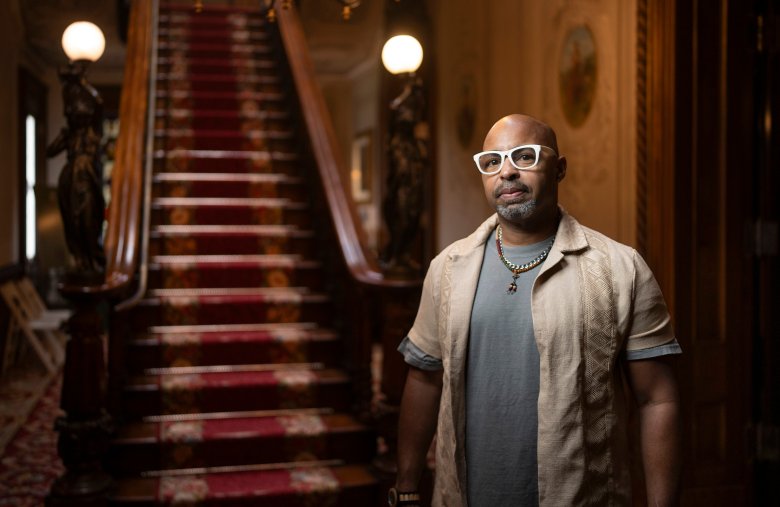PORTLAND — The Victoria Mansion is a colorful place. Light filters through blue and yellow stained glass. The carpet in the main stairwell is a rich red. Gold glints from frames, mirrors, and chandeliers. Every wall and ceiling is painted with intricate designs.
Amidst this vibrant setting, a visitor might easily miss the small black-and-white portrait in a glass case in the foyer. Researchers discovered this image of David Wilson while studying the lives of the people enslaved by the family that built this palatial home.
Ruggles Morse was a luxury hotelier in New Orleans, and docents at the Victoria Mansion now tell visitors how slavery contributed to his success. But the photograph of Wilson is the only one they have.
“This is about people and telling their stories, but the information is fragmentary,” said Executive Director Timothy Brosnihan. “In many cases, we don’t have visuals for them.”
### New Artwork Brings History to Life
The mansion issued a call for an original artwork based on their research, and New Orleans artist Carl Joe Williams responded. He unveiled a painting Wednesday that adds new dimension to this history and will soon be on permanent display at Victoria Mansion.
He calls it *Foundation for the Present, Paid in the Past*.
“It makes you wonder what those people’s lives were really, truly like and the fact that they didn’t really have any control over their lives,” Williams said. “They probably had talents and aspirations and creative notions that couldn’t be fully realized.”
### Digging Deeper into the Mansion’s Past
Built between 1858 and 1860, the Victoria Mansion was originally a summer retreat for the Morse family. The home has been a museum since 1941, styled with nearly all of the original furnishings and finishes.
The family’s participation in slavery and support of the Confederacy were sometimes briefly acknowledged but not studied or discussed in depth. When the pandemic shut down in-person tours, staff and docents used the time for deeper research.
They found newspaper archives detailing the Morses’ social lives and business dealings, including slave auctions common in New Orleans at the time.
In 2021, the mansion launched the Unwilling Architects Initiative to learn more about the enslaved people Morse used to build his fortune. The project has identified at least 27 men, women, and children who were bought and sold by the family in Louisiana.
These individuals likely never came to Maine, but staff felt a responsibility to tell their stories.
“A focus of the past five years, in particular, has been to explore the human history more thoroughly—not just as an important piece of decorative art and art history, but also as a jumping-off point for exploring other themes in American history through the people who were connected to this building,” Brosnihan said.
### Sharing Stories and Exhibiting Findings
Staff created an exhibit in the central stairwell to display their initial findings, including a list—mostly first names—of the people enslaved. The information was added to the website and a visitor pamphlet was created.
Recent discoveries include an 1859 advertisement Morse placed in the *Daily Picayune* offering a $25 reward for the arrest of an escaped waiter at the Arcade Hotel named Jo.
Stacia Hanscom, director of education and public programs, said they have not yet found records of what happened to Jo but hopes the lack of information means he reached freedom.
“Everything is black-and-white copies of newspaper articles,” Hanscom said. “We don’t have any objects or material culture to tie into this story.”
### ‘Black History Is Everywhere’
Victoria Mansion received a $3,000 grant from Coffee By Design’s Rebel Blend Fund to commission an original artwork, and Indigo Arts Alliance helped spread the word.
Jordia Benjamin, executive director of Indigo Arts Alliance, said contemporary art can be a bridge between the past and the future.
“How do we link the past with our present? How do we envision what our future can be?” Benjamin said. “Artists are leaders in that area and have the gift of being able to visualize and provide a path to those futures.”
Benjamin encouraged Williams, who came to Portland in 2021 for an artist residency at Indigo Arts Alliance, to apply.
Williams’ work includes painting, murals, sculpture, music, and video installations. His practice is inspired by history, both personal and global.
“Carl is someone I would consider to be a world builder in a very real way,” said Ashley Page, studio and program manager at Indigo Arts Alliance. “He is really thinking about how he can craft a world around his work.”
Page noted that many Portlanders might not know the real history of this familiar landmark.
“Black history is everywhere, whether people see it or choose to acknowledge it,” she said. “It’s right in front of us.”
### Honoring Ancestors Through Art
Williams studied the research gathered by mansion staff and filled in gaps with his imagination. The painting radiates vibrant color, a contrast to the sepia tones of historic records.
At the center is the Arcade Hotel, where Morse relied on enslaved labor. Surrounding the scene are the faces of people who might have been forced to work there.
“In my work, I tend to honor ancestors,” Williams said. “Those people might have been my ancestors in some way, shape, or form, because I definitely have deep roots in Louisiana and the South.”
The artwork will be on permanent display this spring. However, the research will continue.
While the initial phase was grant-funded, Victoria Mansion has since incorporated the project into its operating budget. Hanscom is pursuing a grant to update the rest of the exhibit and hopes to collaborate with researchers in New Orleans to delve beyond digital records.
“This initiative is a process, and it’s going to unfold into the future, and we’re going to learn more,” Brosnihan said.
### Remembering David Wilson
Meanwhile, visitors can stop in the foyer to study the faces Williams painted, including David Wilson.
After his emancipation in 1854, Wilson worked as a barber for decades. He was active in civic life, advocating for Black children’s access to public education and serving as a delegate at Maine’s constitutional convention in 1867.
In the painting, Wilson is no longer a grainy reproduction but a clear, dignified portrait—bringing his story vividly to life.
https://www.centralmaine.com/2025/10/31/at-portlands-victoria-mansion-an-artist-considers-a-history-of-slavery/



